Normalization Theory
- Decide whether a particular relation R is in “good” form
- If R is not in “good” form, decompose it into set of relations {R1, R2, …, Rn} such that each R is in good form, and decomposition is a lossless
Lossless Decomposition
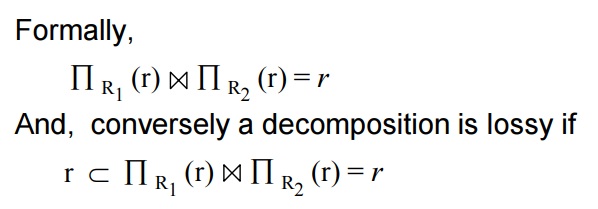
- at least one of the following dependencies is in F+:
- R1 ∩ R2 → R1
- R1 ∩ R2 → R2
- Lossy decomposition example:
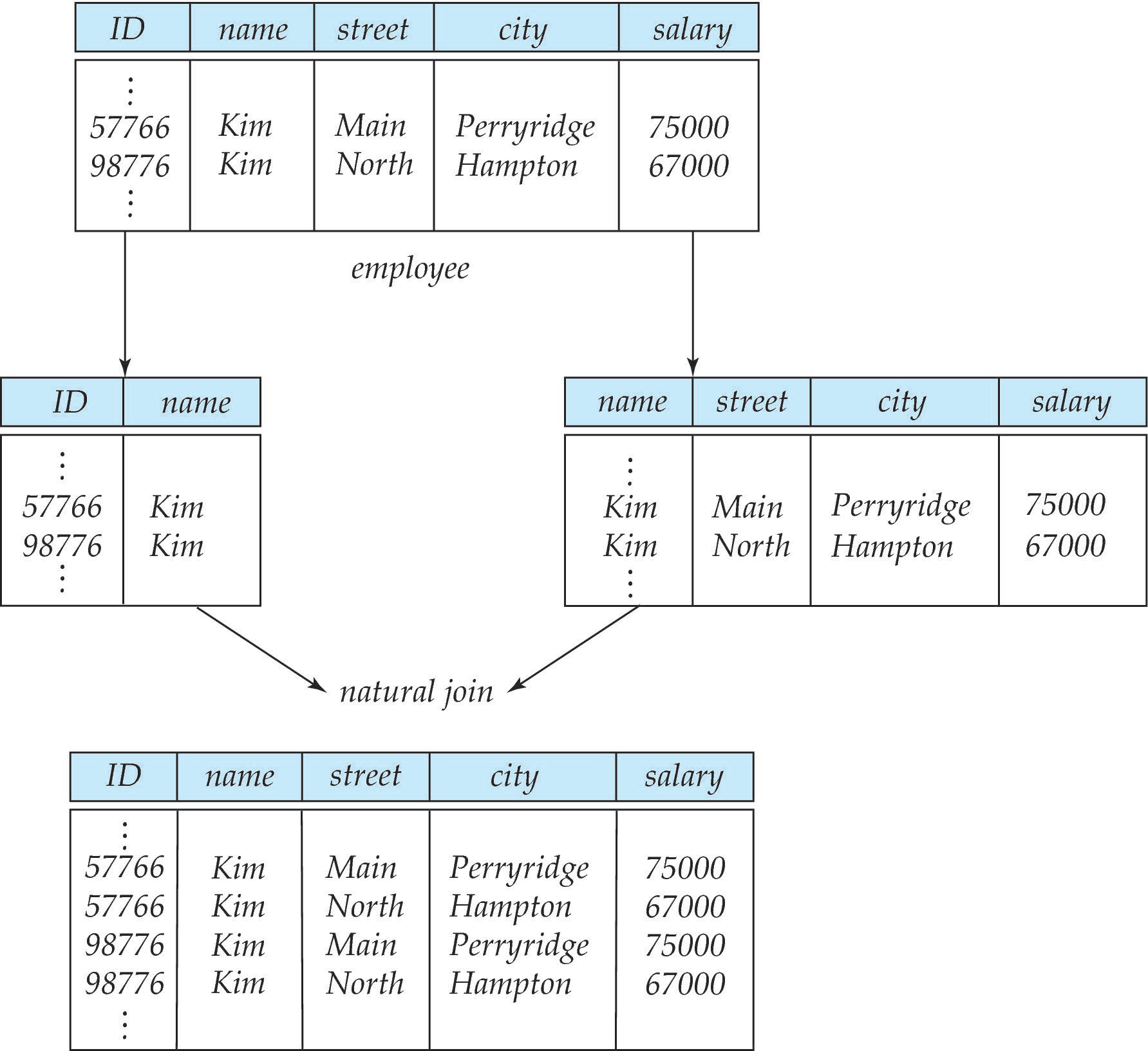
Functional Dependencies
The functional dependency α→β holds on R if t1[α] = t2 [α] ⇒ t1[β ] = t2 [β ]
Note: A specific instance of a relation schema may satisfy a functional dependency even if the functional dependency does not hold on all legal instances
closure of a Set of FD
The set of all functional dependencies logically implied by F is the closure of F(F+)
trivial FD
In general, α → β is trivial if β ⊆ α
Dependency Preservation
A decomposition that makes it computationally hard to enforce functional dependency is said to be NOT dependency preserving.
is_DP
-
A decomposition is dependency preserving, if
(F1 ∪ F2 ∪ … ∪ Fn )+ = F +- exponential time
Closure of Attribute Sets
Given a set of attributes α, define the closure of α under F (denoted by α+) as the set of attributes that are functionally determined by α under F
- Testing for SK
- Testing functional dependencies
- To check if a functional dependency α → β holds (or, in other words, is in F+), just check if β ⊆ α+
- Computing closure of F
1NF

第二范式
第二范式(2NF)要求实体的全部属性完全依赖于主关键字。所谓完全依赖是指不能存在仅依赖主关键字一部分的属性。
第三范式
满足第三范式(3NF)必须先满足第二范式(2NF)。简而言之,第三范式(3NF)要求非主键列必须直接依赖于主键,不能存在传递依赖
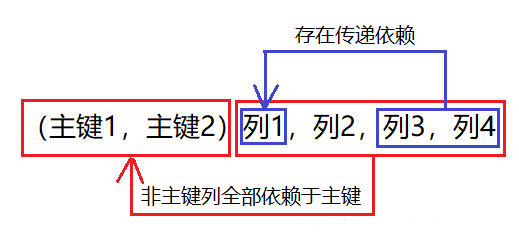
BCNF
- It is not always possible to achieve both BCNF and dependency preservation
- BCNF is lossless-join decomposition
is_BCNF
all FD in F+ of the form α→β
- α → β is trivial (i.e., β ⊆ α)
- α is a SK for R
BCNF_decomposition
α →β be the FD that causes a violation of BCNF
decompose R into: (α U β ) +( R - ( β - α ) )
Redundancy in BCNF
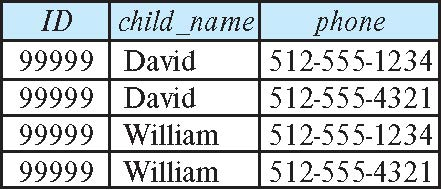
3NF
3NF is a minimal relaxation of BCNF to ensure dependency preservation
is_3NF
if for all: α → β in F (JUST F)
- α → β is trivial (i.e., β ∈ α)
- α is a SK for R
- Each attribute A in β – α is contained in a candidate key for R.
- Testing for 3NF has been shown to be NP-hard
is_3NF in polynomial time
TODO
Redundancy in 3NF
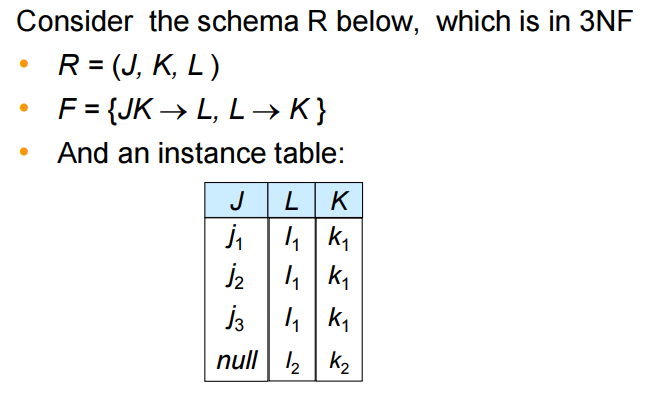
- Repetition of information
- Need to use null values (e.g., to represent the relationship l2, k2 where there is no corresponding value for J)
Extraneous Attributes
An attribute of a functional dependency in F is extraneous if we can remove it without changing F+
Testing if an Attribute is Extraneous
To test if attribute A ∈ β is extraneous in β
- Consider the set: F’ = (F – {α → β}) ∪ {α →(β – A)},
- check that α+ contains A; if it does, A is extraneous in β
To test if attribute A ∈ α is extraneous in α
- Let γ = α – {A}. Check if γ → β can be inferred from F.
- Compute γ+ using the dependencies in F
- If γ+ includes all attributes in β then , A is extraneous in α
Canonical Cover
A canonical cover for F is a set of dependencies Fc such that
- No functional dependency in Fc contains an extraneous attribute
- Each left side of functional dependency in Fc is unique. That is, there are no two dependencies in Fc
Multivalued Dependencies (MVDs)
The multivalued dependency α →→ β holds on R if in any legal relation r(R), for all pairs for tuples t1 and t2 in r such that t1[α] = t2 [α], there exist tuples t3 and t4 in r such that:
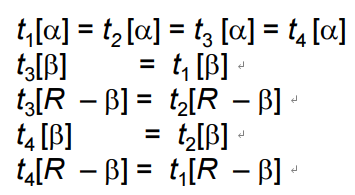
- If a relation r fails to satisfy a given multivalued dependency, we can construct a relations r′ that does satisfy the multivalued dependency by adding tuples to r.
4NF
A relation schema R is in 4NF with respect to a set D of functional and multivalued dependencies if for all multivalued dependencies in D+ of the form α →→ β, at least one of the following hold:
- α →→ β is trivial (i.e., β ⊆ α or α ∪ β = R)
- α is a SK for schema R
If a relation is in 4NF it is in BCNF
Others
ER Model and Normalization
- When an E-R diagram is carefully designed, identifying all entities correctly, the tables generated from the E-R diagram should not need further normalization.
- Good design would have made (FD from non-key attributes of an entity to other attributes of the entity) an entity
Denormalization for Performance
-
May want to use non-normalized schema for performance
- display join of course with prereq
-
Alternative 1: Use denormalized relation
- faster lookup
- extra space and extra execution time for updates
- extra coding work for programmer and possibility of error in extra code
-
Alternative 2: use a materialized view
- Benefits and drawbacks same as above, except no extra coding work for programmer and avoids possible errors
Modeling Temporal Data
Temporal data have an association time interval during which the data are valid